Ancient Papyri Disprove Critics
Revolutionary ideas about the Bible that have been popularized over the past century include the notions: (1) that Constantine (312-337) excluded several valid gospels from our Bibles, (2) that the Epistle to the Hebrews was not writ ten by Paul or any other apostle, (3) that the writings of John could not possibly have been written before the late 3rd century since the dragon and diadem were not Roman symbols until then, (4) that Revelation does not belong in the Bible.
However, the discovery and translation of the three Chester Beatty papyri, published in 1933-1936 by Frederic G. Kenyon, demonstrate the inaccuracy of these heavily promoted modern ideas.
(1) (p45). This papyrus of the early 3rd century has the four gospels and Acts (likely in the sequence Matthew-John Luke-Mark-Acts). Constantine was a century too late to have had any influence on inclusion of these four gospels, or on rejection of the counterfeits (Judas, Peter, Thomas).

The Apostle Peter who influenced the Gospel of Mark.
(2) (p46). Before it is broken off, this papyrus of about 200 AD has most of the Epistles of Paul, but with Hebrews between Romans and Corinthians, and Ephesians before Galatians. Thus, the early Christians regarded Paul as the author of Hebrews.
(3) (p47). This papyrus of the early 3rd century contains the center third of Revelation. The manuscript was written far from Patmos, and half a century earlier than the school of higher criticism would have had us believe possible. [A papyrus fragment in the John Rylands Library in Manchester, England (p52) has a few verses from John 18, copied in Egypt perhaps about 125 AD – less than half a century after John penned that gospel.] The prognostication (foresight, foreknowledge) of dragon and diadem simply validates the prophetic character of Revelation.
– James Parkinson
